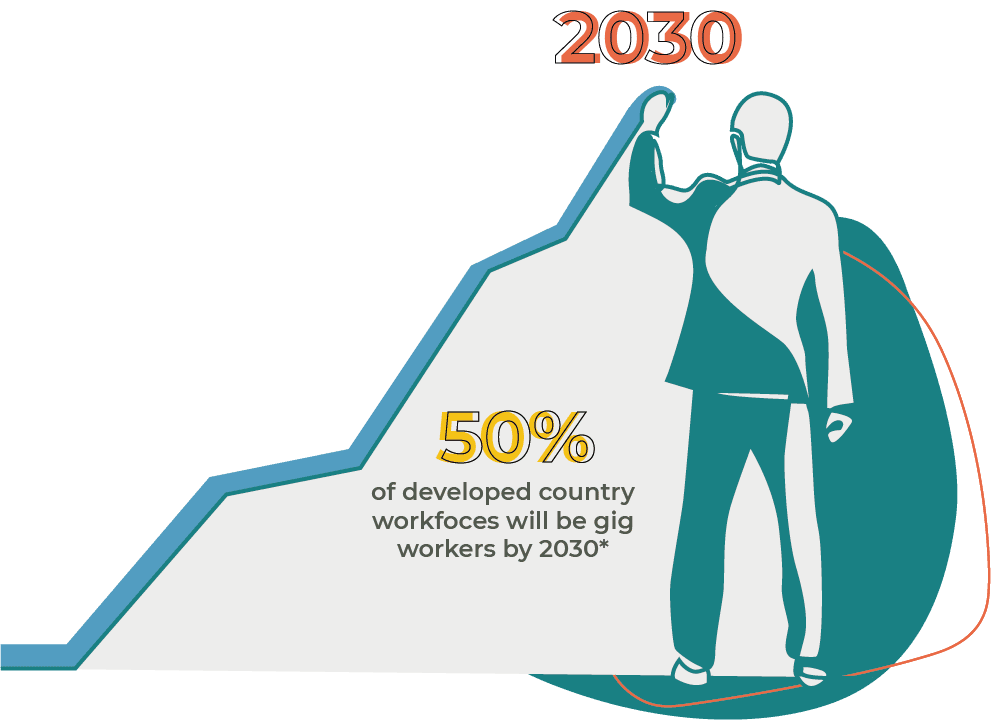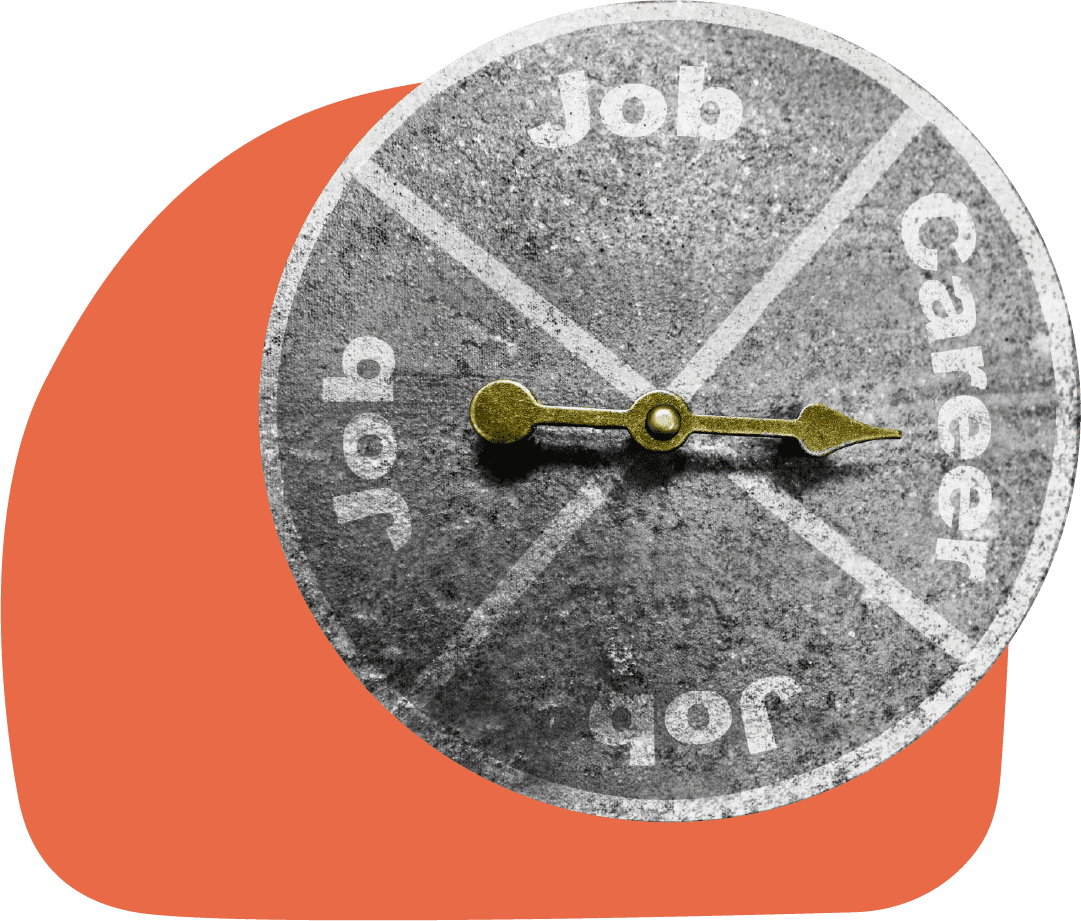Ben Legg
The COVID-19 pandemic has accelerated the need for career change for millions of people across the world. This includes many professionals leaving their main-gig roles in order to develop career change ideas using a portfolio career.
To manage financial risk and pave the way for a portfolio career, many other people with main gigs are also setting up side hustles.
Long before lockdown, the OECD Future of Work study predicted that 50% of developed country workforces would be gig workers by 2030.


The phrase “gig workers” meant that many white-collar professionals thought that this didn’t refer to them – only to Uber drivers, food delivery people, and the like.
However, in reality the long-term reduction in permanent roles affects almost all job types and would require professionals to look for career change ideas.
Why did companies make permanent hires?
Historically, companies wanted to hire permanent white-collar employees for a number of reasons:


SCARCITY
Locking in talent was important when it was so hard to find.


TRAINING
Mastering “the company way” took time and resources.


TRUST
At a time where monitoring quality was difficult, you needed to trust your employees not to steal from you or neglect quality.
Why did professionals want permanent roles?
Likewise, professional workers also had their reasons for wanting permanent jobs:
CAREER
Many companies promoted from within. To get to the top, you had to be prepared to stay for many years.
PENSION
In the days of “defined benefit” pensions, it made sense to stay in one organisation for a long time, to get the best possible pension.
BENEFITS
In the US, healthcare was (and still is) generally paid by the employer for their main-gig employees. Meanwhile globally, other benefits were often linked to time served.
SOCIAL PRESSURE
Changing employers too often was considered unethical, and could make you less employable elsewhere.
LACK OF TRANSFERABLE SKILLS
In the pre-internet, pre-consulting, pre-MBA world an enormous amount of company knowledge wasn’t codified – it was learnt on the job and was considered company- or industry-specific. Therefore, it was hard to develop career change ideas, learn, or demonstrate transferable skills that could help you move between companies, industries, or functions.
From jobs for life, to jobs for a few years, to jobs for a few weeks
The average age of companies in the S&P 500 has changed from 30 years old in 1980 to just 10 years old now.
Old companies were declining and new companies were hiring, leading to more job switching. Mid-career changes of employer, stimulated by studying for an MBA, or being poached by a head-hunter, also became more common.
The internet then accelerated this trend further. Now, we have LinkedIn and other job sites, online training, video conferencing, dashboards to track almost anything. Working in a startup is considered cooler and a faster way to both learn and get rich than going to a big, established company. It also leads to more churn, as startups pivot often.
Given all this, the average time that professionals stay at each employer has been drifting down, and is now below three years per employer.
Most white-collar professionals are now working from home, so companies can hire talent from anywhere in the world – not just near their offices. And when hiring remotely – especially abroad – it is much easier to hire contractors rather than permanent roles.
For those on furlough, side hustles as well as unique career change ideas have become more mainstream whilst they use the time “off” to gain more experience or build up their dream careers.


So, what will the future look like now?
Employers want far fewer permanent employees
Employers don’t need, or want, as many permanent employees as they had before:
- TALENT MOBILITY
Well-matched talent can be easily found on LinkedIn etc so there is now less of a need to lock in talent so tightly as before. Plus, the required skillsets vary over time, and new blood is seen as a good thing to “fill the gaps”. - NEED FOR FLEXIBILITY
Agility is key, temporary workforces make spinning up new teams and closing down others much easier and at a much faster rate. - HYPER COMPETITION
Excelling in the global economy requires being the best in the world, and to do that you need to tap into world class talent and global expertise. Such people are often only available as consultants rather than permanent hires. - TRAINING
Companies are now more able to explain how they operate to newcomers, so it is now much easier for outsiders to turn up, understand how a company works, conduct a project successfully, then walk away. - TRUST
It is much easier to trust outsiders now. There is no cash, most “deliverables” are digital and trackable, and people who do let you down would ruin their reputation and therefore their future earnings.
Given all of these changes, the only professional roles that are likely to remain permanent are those that require long term continuity and/or at least 40 hours per week for the foreseeable future.
A portfolio makes sense for ALL professionals


People manage their own careers rather than waiting to be promoted; pensions are moveable; there is no social pressure to stay at one employer, and it is easy to learn transferable skills.
The only outstanding factor that might tie some workers to wanting a main gig is healthcare, and that is only in the US (and is a solvable problem, albeit an expensive one).
Indeed, it can be argued that a portfolio career makes sense for almost ALL professional workers, even if they have a main gig.
The benefits of a portfolio career include:
- It provides a diverse source of income, reducing risk.
- You can usually do the work from home.
- Typically, the work offers flexible hours, so you can utilise evenings or weekends.
- You pay lower taxes (you can offset a lot of personal expenses against this work).
- It creates a back-up plan, just in case you lose your “main” job.
- You can learn new skills and expand your network.
- It can be really easy money if you find your specialty niche.
- It might lead to new permanent offers with your new clients (if you still want a main gig).
This new normal of portfolio working must be an economist’s dream.
Every professional will be continuously striving to earn the maximum hourly rate, forever innovating – learning new skills, trying new things, and reinventing themselves forever. In this world, supply and demand of labour will be more synchronised than ever before, and human productivity will be higher too – which should lead to increases in GDP per hea
Think this sounds like the right path for you? Come along to our monthly Get started event for new members to find out what a portfolio career could look like and how The Portfolio Collective can help you take those first steps towards professional success – and don’t forget to connect with our community!



